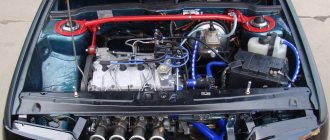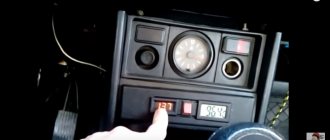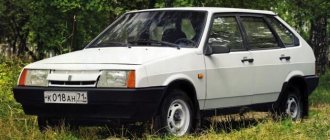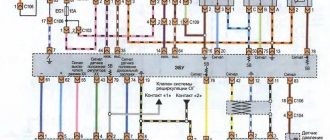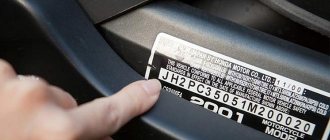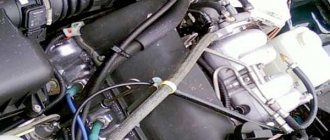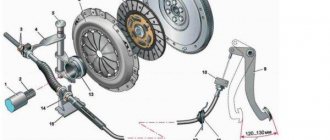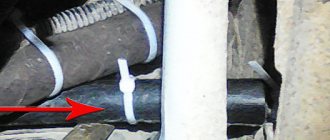Background[edit | edit code]
In the mid-1950s, NAMI developed a promising type of minicars and their units, planned for development during the implementation of the Seven-Year Plan for the Development of the National Economy (1959-1965). This type included three types of cars: a four-seater general-purpose microcar intended for sale for individual use (the future ZAZ-965); a two-seater microcar for disabled people, designed to replace wheelchairs from the Serpukhov plant (the experienced NAMI-031, did not go into production) and a light multi-purpose cargo-passenger vehicle, designed to transport four people, or two people and 200–250 kg of cargo.
The development of the latter concept was started by NAMI in 1958 together with the Irbit Motorcycle Plant with the construction of a prototype NAMI-049 “Ogonyok”, the design of which was largely based on the previously developed military amphibious all-terrain vehicle NAMI-032G (late 1956 or early 1957). The car had a steel supporting base and body frame (pillars, windshield frame, tailgate opening), onto which fiberglass outer panels (tails, doors, hood, side) were attached. As a result, an optimal combination of weight was achieved - only 752 kg in running order - and dynamic qualities - the maximum speed with a 22-horsepower Irbit MD-65 engine was 80 km/h, as well as fuel consumption - 6.7–7.1 l/ 100 km, depending on road conditions. Independent torsion bar suspensions on trailing arms, permanent drive to the front axle with the rear axle being disengaged, lockable wheel differentials, and wheel gearboxes were used. The carrying capacity was 300 kg with two passengers, or four passengers.
Subsequently, the designers of a repurposed for the production of minicompact cars (Zaporozhye, Ukrainian SSR) joined the work on the car, on which prototypes of the NAMI-049A “Tselina” (light truck) and ZAZ-969 were created, unified in the power unit with the ZAZ model that had just been mastered by the plant -965 “Zaporozhets”.
Origins and photos of LuAZ 969
Changes began when the TPK (front line conveyor) concept was developed specifically for the Airborne Forces at the Research Automobile and Motor Vehicle Institute. It was an ordinary motorized cart that was parachuted from an airplane and, in addition to the driver, carried several stretchers or six wounded people in a sitting position. Mandatory requirements were a low silhouette, all-wheel drive and a winch. In addition, the TPK was an amphibian, that is, it swam by rotating its wheels. The prototype was named “Ogonyok” with the index NAMI-049. In addition to all-wheel drive, it was equipped with an independent torsion bar suspension, center and two cross-wheel locking differentials and gearboxes. The conveyor was driven by a 22-horsepower engine, so it was decided to further develop this project.
NAMI-049A was already equipped with a steel body with an awning (the previous model had a body made of fiberglass). The chassis has undergone some changes: the center differential has been removed, and the rear axle has been made switchable, making it possible to drive on asphalt roads. More important than anything else was the installation of a new 27-horsepower 0.9-liter engine, the same one that was later installed on the famous “humpbacked” Cossack.
Watch the story about unknown Soviet SUVs that remained models.
Car subframe: why is it needed and how to make a subframe for Niva 2121? More details here.
In this form, the TPK began to be produced in Lutsk as the LuAZ 967. Until 1989, these cars were produced in large quantities, having undergone several modernizations and, as they say now, redesigns. In 1969, LuAZ finally reached the military, where it was used as part of motorized rifle and airborne units.
LuAZ also proved itself outside the USSR in other Warsaw Pact countries. The amphibious transporter, according to some experts, has no analogues to this day. Over time, the LuAZ no longer became a cart and a light jeep, and in some modifications it even acquired its own weapons.
The civilian version of the transporter has undergone a number of design changes, the main one of which is the abandonment of buoyancy. Adapting the car for the needs of villagers, the design engineers changed the seating position of the driver and passengers, added fastening canvas sidewalls, and gave some semblance of shape to the body contours. The modified conveyor under the index 969 was produced in the first thirty units in Zaporozhye, after which production was transferred to the same Lutsk Automobile Plant.
Modernization
The first Bagpipe models, despite the use of advanced technologies, had many shortcomings. Therefore, the Lutsk Automobile Plant soon raised the question of modernizing the SUV. This is how the first modification of the LuAZ-969M was born.
First of all, the designers sought to increase engine power. But the chassis was not left without attention. The body and interior have been significantly improved. The design of the car also changed a little - for the first time on the Bagpipe, full-fledged windows appeared on the side, and the seats began to be equipped with seat belts. Attention was also paid to the issue of sound insulation. The solution to this problem was the installation of appropriate panels.
The modernized car did not lose its position and was actively sold in the domestic market. And even now there are a lot of advertisements for the sale of this miracle of the Soviet automobile industry.
Appearance
Despite its small size, the body consists of an integrated spar-type frame. Volyn is equipped with a tent top, which allows it to be universal. Small doors hang on hinges, thereby simplifying installation and dismantling.
The 969th model also differs from other cars in that the windshield wipers are attached to the top, and not, like other cars, to the bottom, which is a positive thing when driving in bad weather.
If in the previous model the arcs were needed only for attaching the awning, then in the “M” version they come already in a strengthened state. They protected the interior when the car rolled over. When updating the LuAZ-969M, it received new lighting equipment. Locks were installed on the doors, and seat belts appeared.
One of the most serious drawbacks of the bagpipe body was its susceptibility to corrosion. But this disadvantage can be easily solved with a simple brush. The awning does not have any particularly negative aspects, however, those who like to travel along forest roads should install a hard metal roof.
Then it will no longer be scary that branches can tear the roof. With the arrival of the update, the appearance of the vehicle was changed. For the first time, Bagpipe began to have full-fledged windows.
In addition, special attention was paid to sound insulation. They installed a windshield with a different shape, and the doors already had locks (that’s what you thought, they had never installed locks before!).
The front body became less angular, and the car began to look different. It's not so easy to believe, but a small car, from a small city in the big Soviet Union, was able to achieve international recognition.
And these are not just words, for example, even before serial production, in 1978, at the International Motor Show in Turin, the 969th model entered the top 10 best off-road cars in Europe!
It is clear that the automotive market for off-road models was previously a little different, but this does not change the essence of the matter.
LuAZ-1302
Kirill was practically flying to meet his dream. The previous owner of the car, an elderly summer resident, was dealt with instantly. And so our hero found himself behind the wheel. As he says now, the first experience was a nightmare - driving around Moscow in a Luazik turned out to be a real torture. It didn’t accelerate and didn’t really slow down, didn’t hold its trajectory, was terribly noisy... In general, it showed itself to be what it really was, namely a Spartan car designed 40 years ago. The path to the country house became eternal for Kirill and cost a billion nerve cells. Then I had to spend a lot more on re-registration. The traffic cops were surprised when they saw the LuAZ, recognized it as a foreign car (but what if it was a Ukrainian car) and could not read the engine number. It was possible to overcome bureaucratic obstacles through the combined efforts of the two owners of the car - the previous and the new one.
Ignition system features
Since the civilian version of the car could not swim, the ignition systems were designed according to the classical scheme:
- Battery-coil design with one spark plug per cylinder;
- The battery is standard 6ST-55;
- Alternating current generator G-501 (or G-502 on modifications);
- Rectifier unit BVG-2A;
- Blocking relay;
- Fuses (6 pcs).
LuAZ 969 instrument panel with fuses.
Also on the instrument panel there are 2 thermometallic fuses with a nominal value of 20A for protection:
- Heater electrical circuit;
- Lighting of the body and engine compartment;
- Plug sockets;
- Sound signal;
- Brake alarm systems (see also wiring diagram Niva 21213).
https://youtube.com/watch?v=tkANFBOcU8w
A bimetallic fuse is also used to protect the windshield washer and wiper circuit. It is installed under the hood and has a response threshold of 3.5A.
Salon
The seat of the SUV was borrowed from ZAZ. Among the instrument sensors you can find an ammeter, which shows the voltage in the electrical network. By the way, the transmission oil temperature is also displayed for the driver. The interior decoration, to put it mildly, leaves much to be desired. Everything is very simple and in retro style. The car was clearly not created for city traffic, but mainly for off-road driving, and therefore for the countryside. The instrument panel, standard for army vehicles, received a more civilian look and became more pleasant to look at.
LuAZ-969M "Volyn" photos
photo of LuAZ-969 “Volyn”
photo of LuAZ-969 “Volyn”
photo of LuAZ-969M “Volyn”
photo engine LuAZ-969M “Volyn”
photo of LuAZ-969M “Volyn”
photo of LuAZ-969M “Volyn” on tracks
Design[edit | edit code]
The body of the LuAZ-969 car is semi-supporting, with an integrated spar-type frame. The layout of the car is characterized by a strong displacement of the passenger compartment forward, which made it possible to achieve a constant high load on the front axle, thereby ensuring high traction and grip properties even when driving only the front wheels.
The engine is a V-shaped, four-cylinder, very close to the engines of small cars of the Zaporozhets brand. Until 1975, LuAZ was equipped with a MeMZ-969 engine with a displacement of 877 cm³ and a power of 30 hp. With. (analogous to Zaporozhets engines models 965A and 966B), after - MeMZ-969A, 1197 cm³ and 40 hp. With. (analogue 968). Regardless of the version, the engines were equipped with a cooling system with a forcing (and not an exhaust, as in early Zaporozhets models) fan, which took air through a grille in the front end lining and drove it through the cooling jackets of the engine heads and cylinder block, while the direction of the flow The air was set by a system of sheet metal casings installed on the engine (much less developed, however, than on later Zaporozhets models). In addition, the lubricating oil circulating in the engine was cooled in the oil cooler and in the engine crankcase, the pan of which had a ribbed surface that facilitated heat dissipation. Unlike the Zaporozhets, there were no thermostats in the engine cooling system; the engine temperature during warm-up and in winter conditions was maintained manually by the driver due to the blinds installed between the front end lining and the fan, driven by a handle on the instrument panel (which was much more reliable than automatic adjustment of air flows on "Zaporozhets"). Made as a separate unit, the interior heater could be used in winter to preheat the engine.
Transmission diagram for LuAZ vehicles (all-wheel drive version).
The LuAZ transmission as a whole is characterized by a comparative simplicity of the device by the standards of SUVs (double-shaft gearbox, absence of cardan shafts and transfer case), which has a positive effect on the weight-dimensional characteristics and reliability. The main gear and twin-shaft gearbox are located in the front of the car and are combined into a single unit (transexl), partly similar to that used on Zaporozhets cars (the crankcase, except for the rear cover, and many other parts are unified with the gearbox of 1.2-liter 40-horsepower models "Zaporozhtsev"). Gear shifting is carried out by a floor lever located on the rear cover of the gearbox housing, and the shift layout differs from the traditional one (“mirror”): the first gear is engaged by moving the lever from neutral towards you and back, the second - towards you and forward, the third - from neutral back , fourth - from neutral forward, reverse - from neutral away from you and forward. A power take-off mechanism from the secondary shaft, used either to drive various agricultural equipment, or (on all-wheel drive versions) to drive the rear axle, and (also on all-wheel drive versions) a reduction gear is also mounted inside the gearbox housing cover.
From the very beginning, the gearbox of LuAZ cars had a fully synchronized series of forward gears and a hydraulic clutch (its external feature is a technological connector in the middle of the main gear housing) - unlike the Zaporozhets, whose versions with engines with a working volume of 750 and 877 cm³ were equipped with a different architecture (“Fiat”) gearbox with unsynchronized first gear and cable-operated clutch (with a technological connector between the clutch bell and the gearbox housing itself). The LuAZ variants with the 877 cc MeMZ-969 engine differed from the later 1.2-liter ones only in a different clutch bell (made together with the front half of the final drive housing). The gearbox for the Zaporozhets with a 1.2-liter engine was designed on the basis of the LuAZ transmission by eliminating the power take-off mechanism with reduction gear from its design, installing a pair of fourth gear gears with a higher gear ratio and developing a new gear shift mechanism designed for remote traction drive.
For all-wheel drive modifications, rotation is transmitted from the power take-off shaft of the gearbox to the rear axle gearbox using a thin shaft without hinges, enclosed inside the transmission pipe connecting the gearbox and rear axle housings. Thus, all the vehicle’s transmission units, except for the axle shafts, are essentially enclosed in a common sealed crankcase, which is a legacy of LuAZ’s amphibious past. The rear axle is disabled in the normal state of the transmission; it can be connected from the driver’s seat, for which it is necessary to move the lever located to the left of the gearshift lever to the rear position (with the lever in the forward position, the rear axle is correspondingly disabled). There is no center differential, so when driving on paved roads, the rear axle must be disengaged, and the car becomes front-wheel drive. The same lever also controls the inclusion of a downshift - to engage it in the connected rear axle mode, you must move the rear axle connecting lever away from you and move it forward, while the gearbox lever must be in the neutral position.
To prevent one of the rear wheels from slipping, the rear axle differential can be forcibly locked from the driver's seat by a curved lever located next to the parking brake lever. The locking mechanism is with a gear coupling. There is no front axle differential lock.
The suspension is torsion bar, on trailing arms, with large strokes. The wheels are 13-inch, with a developed mud tread pattern. The wheel pattern corresponds to that used on rear-wheel drive Moskvich cars, but the wheels themselves are original, with a large positive offset, and, unlike other AvtoZAZ products, they have a disk design.
Brakes are drum brakes on all wheels, hydraulically driven, without power assistance.
Engine heating system
In winter, to ensure easy cranking of the crankshaft, low-viscosity oils with a low pour point are used. However, at very low air temperatures, these oils thicken and the engine requires heating. When the engine is heated, the viscosity of the oil decreases and good mixture formation is ensured during engine starting.
To warm up the engine you need to:
- Open the damper of the camber heating pipe with handle 7 by turning it counterclockwise until it stops. At the same time, the damper for supplying hot air to the car interior will close;
- open the damper of the engine crankcase heating manifold, for which move rod 5 to the uppermost position;
- turn on the heating installation;
- warm up the engine for 20-30 minutes (depending on the ambient temperature);
- After the specified time has passed, without turning off the heating installation, turn the crankshaft using the starting handle, making 4-5 turns. If the crankshaft turns easily and compression is felt in the cylinders, start the engine. After starting the engine, move the dampers to their original position to heat the passenger compartment.
Rice. Engine pre-heating: 1 — engine sump shield; 2 — bolt securing the engine heating manifold to the sump panel; 3 — engine heating manifold; 4 — bolt securing the manifold to the exhaust pipe; 5 — collector damper rod; 6 — exhaust pipes; 7 — handle for the damper of the camber heating pipes
Modernization[edit | edit code]
LuAZ-969A[edit | edit code]
In 1975, the LuAZ-969A
with an improved MeMZ-969A[1] engine (1.2 l, 40 hp). This was the first Lutsk car to bear the LuAZ brand. It could be distinguished from ZAZ-969V and ZAZ-969 by the presence of a window in the awning. About 30.5 thousand cars of this model were produced.
In 1977, a batch of closed all-metal vans was also produced. In E. Thompson's work on Soviet cars it is designated as LuAZ-969F.
LuAZ-969M[edit | edit code]
| LuAZ-969M "Volyn" | |
| Manufacturer | LuAZ |
| Years of production | 1979—1996 |
| Body type | 3-door phaeton (2 (4) seats) - station wagon |
| Platform | LuAZ-969 |
| Type | carburetor |
| Volume | 1198 cm3 |
| Maximum power | 40 l. s., at 4100−4300 rpm |
| Configuration | V4 |
| Cylinders | 4 |
| Valves | 8 |
| Max. speed | 120 |
| Cylinder diameter | 76 mm |
| Piston stroke | 66 mm |
| Compression ratio | 7,2 |
| Supply system | Carburetor |
| Cylinder operating order | 1-3-4-2 |
LuAZ-969M
(in development since 1973) was introduced in November 1977[2], mass production was launched in 1979, it was distinguished by an increased mileage to 100,000 km before the first major overhaul, updated components (a more powerful 6TST-50EMS battery, new headlights) [1], as well as the shape, design and finish of the body. A noticeable difference in appearance is the modified front part.
- LuAZ-969M
- Back view
- LuAZ-969M
- Driver's workplace
This model was equipped, like its predecessor, with a 1.2-liter 40-horsepower MeMZ-969A engine, but was equipped with a separate brake drive with a hydraulic vacuum booster on the front circuit. The exterior of the car has been modernized: the front panels and the shape of the windshield have changed. The doors were equipped with locks, their side windows received a rigid frame and opening “windows”, a soft instrument panel, a safety steering column and “Zhiguli” seats appeared in the cabin.
Even before the launch of the series, the LuAZ-969M was highly praised at the Exhibition of Economic Achievements of the USSR, and in 1978, at the international salon in Turin (Italy), it (as indicated in a number of sources) entered the top ten best cars in Europe. In 1979, at an international exhibition in the city of Ceske Budejovice (Czechoslovakia), he received a gold medal as one of the best cars for village residents.
LuAZ-2403 was created on the basis of this vehicle.
.
LuAZ-1302[edit | edit code]
Maximum lateral stability angle - 40 degrees; Fording depth - 0.5 m; Wheels:
- wheels - 4.5J/13;
- tires - 175/80R13.
In 1991, small-scale production of LuAZ-1302
. The key difference between this modification is the MeMZ-245-201K generation engine, intended for Tavria and LuAZ-1301[3] (1.1 l, 53 hp, liquid cooling).
External differences from the “969M” consisted of the appearance of a thick spacer between the front panel and the front wings, as well as the transfer of the side lamp from the sidelight to the headlight. The car had reinforced side members, a new instrument panel, additional noise and vibration insulation and more comfortable seats from Tavria (in the production part, old Zhiguli seats were installed). Fuel consumption and noise have decreased significantly, dynamics have improved.
On May 9, 2002, the plant decided to stop production of LuAZ-1302 (instead of which it was planned to master the production of LuAZ-1301M)[4].
Specifications
The LuAZ-969M is powered by a MEMZ 969A engine, located in a V-shape and air-cooled. This of course simplifies its design, but on the other hand, if necessary, does not provide it with proper cooling. The unit comes with a volume of 1.2 liters and produces 40 horsepower. The engine is synchronized with a 4-speed manual transmission. The gas tank capacity is 34 liters. The 969M has an independent torsion bar suspension.
LuAZ is equipped with a reduction gear, which provides the necessary start and effort before any obstacle. In standard mode, the car is driven by the front wheels, but if necessary, you can connect the rear axle and engage the rear differential lock. Hydraulic drum brakes are installed on both the rear and front of the car. The vehicle provides acceptable cross-country ability.
One of the disadvantages of the LuAZ car is its power unit, which migrated from the Zaporozhets. Among the main disadvantages are:
Therefore, if you plan to purchase this SUV, you should stock up on a second spare engine. The transmission stands out for its reliable qualities, although it has its own “surprises”, such as mixed up gears, etc.
The brake system was borrowed from the Moskvich 412, which in turn does not indicate good quality. The steering column looks good if you properly care for it, for example, regularly lubricate the steering rods with a syringe. Wheel gearboxes often begin to leak. Therefore, it is necessary to have repair skills, which, by the way, you will acquire by repairing Luaz. Regarding the suspension, it has an independent, torsion bar, trailing arm suspension with shock absorbers, both front and rear. It accelerates to 80 km/h in 24 seconds.
Engine
A similar power unit was installed on some Zaporozhets cars. Based on the passport data, the average fuel consumption of this mini-SUV when driving at a speed of 60 km/h is 10.0 liters per hundred. In other words, a full Volynka gas tank should be enough for 300 - 350 km of travel. But you should understand that this Luaz 969 car will not allow you to develop a very high maximum speed, since it is set at 85 km/h. However, this should not be too surprising, because it was not created for racing tracks, but for off-road driving, where it fully reveals its advantages.
If we talk about the transmission, the Luaz 969m has a very simple design that will not cause problems for car enthusiasts. But the only drawback is that it is not easy to find the necessary spare parts, due to the fact that Luaz has long been discontinued. The parts themselves are quite affordable. Considering the reviews from the owners of this SUV, we can conclude that most of them are positive characteristics.
Modifications[edit | edit code]
Family "969"[edit | edit code]
- ZAZ-969V
/
LuAZ-969V
/
LuMZ-969V
(1966 or 1967—1971 or 1972) - temporary version, front-wheel drive; - ZAZ-969
/
LuAZ-969
(1971-1975) - serial with a 4x4 wheel arrangement; - LuAZ-969A
(1975-1979) - first modernization, MeMZ-969A engine; - LuAZ-969M
(1979-1996) - second modernization, updated body;
Family "1301" (experimental)[edit | edit code]
The project to update the LuAZ SUV model range is not to be confused with the next LuAZ-1301 platform.
- LuAZ-1301
(experimental car of 1984) - is a platform (chassis and engine) of LuAZ-969 (the “969M” modification was taken as the basis) with a new body. Later the engine was replaced with a motor from Tavria.
Family "1302"[edit | edit code]
Options with liquid-cooled engines, mainly MeMZ-245. Production ended May 9, 2002[5]
- LuAZ-13021
(prototype) - a cargo modification of the LuAZ-969M with a base extended by 200 mm and a cargo platform[6]. Subsequently, the type of onboard body was changed, and the base for the production model became 1302; - LuAZ-13021
is a serial flatbed truck with a carrying capacity of 400 kg[7]. Some options were equipped with a gearbox from Moskvich-2141 without drive to the rear axle; - LuAZ-13021-03
- modification of model 13021 with a normal rigid cabin and a sunroof; - LuAZ-13021-04
is a long-wheelbase cargo-passenger modification of model 1302, created for mobile repair teams to maintain power lines and pipelines. There are four seats in the double cab; up to 250 kg of cargo can be transported on a shortened cargo platform[8]; - LuAZ-1302-05 “Foros”
(1998) - a commercial modification of the LuAZ-1302 with a 37-horsepower Italian diesel engine “Lombardini” LDW-1404 and an open body with roll bars[9]. - LuAZ-13021-07
- a variant of model 13021-04 with an extended van-type body with a fiberglass top and a metal tailgate[8] - LuAZ-13021-08
is a modification of model 13021-07 for the Ambulance service. The top is made of fiberglass. To conveniently accommodate stretchers, the rear part of the body has been lengthened by more than 600 mm, resulting in an increased rear overhang. The body has four doors: one on the left, two on the right and a rear one[8]
Reliability and safety
If we talk about the durability and reliability of this vehicle, then there are many conflicting opinions among drivers. A clear advantage is the Zaporozhye power system itself, which is included with the machine.
It is located in front, which avoids difficulties with its overheating. However, it also has its own rather significant drawback - low engine life.
Speaking about the devices themselves that ensure the safety of the driver and passengers of the car, this model simply does not have them. You won’t find seat belts or airbags here, which are simply “stuffed” with cars of the latest generations.
Such decisions can be explained quite easily - in those years when the car was being designed, no one thought much about it. Therefore, when driving such an off-road vehicle, you will be able to get unique sensations that cannot be found on modern jeeps.
LuAZ-1302
Lunokhod-2, -3
The first to fall victim to the “grinder” were the standard running boards. They resembled stirrups. The leg of a normal adult did not fit in them, but they clung perfectly to all the “folds of the terrain”, anchoring the car. The second point was the wheels. Kirill managed to purchase a Portuguese Fedima Extreme 4x4 195R14. It turned out that these are almost the only off-road tires in the world that can be installed on LuAZ without major modifications. The tires were mounted on wheels from an old Mazda 626. The most important acquisition was a three-ton MasterWinch winch. To fit it to the car, I had to order a power bumper from a local welder. He welded it conscientiously, but in accordance with his own ideas about functionality and aesthetics. The bumper, made of a thick steel sheet, weighed a hundred pounds, protruded forward almost a meter and completely turned the car into an alien. However, at the next competition, the monstrous design came to the rescue when the car’s clutch was filled with swamp slurry and we had to get about three kilometers to the camp, “throwing over” (using a winch) every hundred meters. And this experience showed that preparation for the trophy should be even more serious.
Prices and options
Since the vehicle was discontinued from serial production a long time ago, it is only possible to buy it second-hand. To ensure that the choice is not wrong, you need to carefully find a car and review a whole stack of advertisements.
It often happens that the car has been subject to corrosion, and it is very unpleasant when the rust eats away the bottom. Generally speaking, the Bagpipe has always had such a drawback, so after the purchase, car owners often have no choice but to weld the body in a new way.
Although, if you look at its cost from a different perspective, which ranges from $200 to $1,000, the compact Soviet SUV can be forgiven, if not everything, then a lot. It’s interesting that you can find advertisements online where Lutsk cars are for sale from $3,000 to $5,000.
It is clear that based on such a cost, the technical condition of these machines is as if they had recently rolled off the assembly line, or they had been tuned. Although the easiest way is to buy a model for $200 and then “upgrade” it with your own efforts, provided that you have free time.
LuAZ-1302
He was imbued with sympathy for LuAZ in absentia. His first serious technical hobby was the Vyatka scooters (domestic copies of the Italian Vespa), then there was the period of the Volga GAZ-24, which he went over with his own hands. Somehow I accidentally noticed LuAZ, started collecting information about Lutsk cars, an interest arose, which resulted in the purchase of my own car. Three years ago... We can say that at that moment a real turning point occurred in Kirill’s life.
Advantages and disadvantages
Pros of the car
- Good off-road performance;
- Spacious interior;
- Low cost of repaired parts;
- Low cost of the machine;
- Small dimensions of the car;
- You can upgrade it yourself;
- Ease of Management;
- Inexpensive to repair;
- Acceptable ride height;
- Good maintainability;
- Canvas top;
- Not a bad gearbox.
Cons of the car
- Not reliable and not long-lasting LuAZ engine;
- Low sound insulation;
- Hard chairs;
- Low maximum speed;
- Lack of security devices and systems;
- The presence of a canvas top;
- High tendency of body metal to corrosion;
- It is not easy to find the necessary parts for a car;
- Hot in summer, cold in winter;
- Small wheels;
- Weak engine;
- Meager interior;
- Noisiness;
- There is no water cooling of the power unit.
Let's sum it up
Despite the simplicity of the interior and unstylish appearance, the LuAZ-969M is perfect for lovers of fishing and hunting and will find its use in rural areas. The advantages include: low price of the car, ease of repair, abundance of various spare parts, good off-road performance. There are, of course, disadvantages: the lack of an attractive interior, appearance and comfortable seats, a rather weak engine, narrow wheels, which will sink into the ground especially when loading the car, lack of water cooling.
Source



